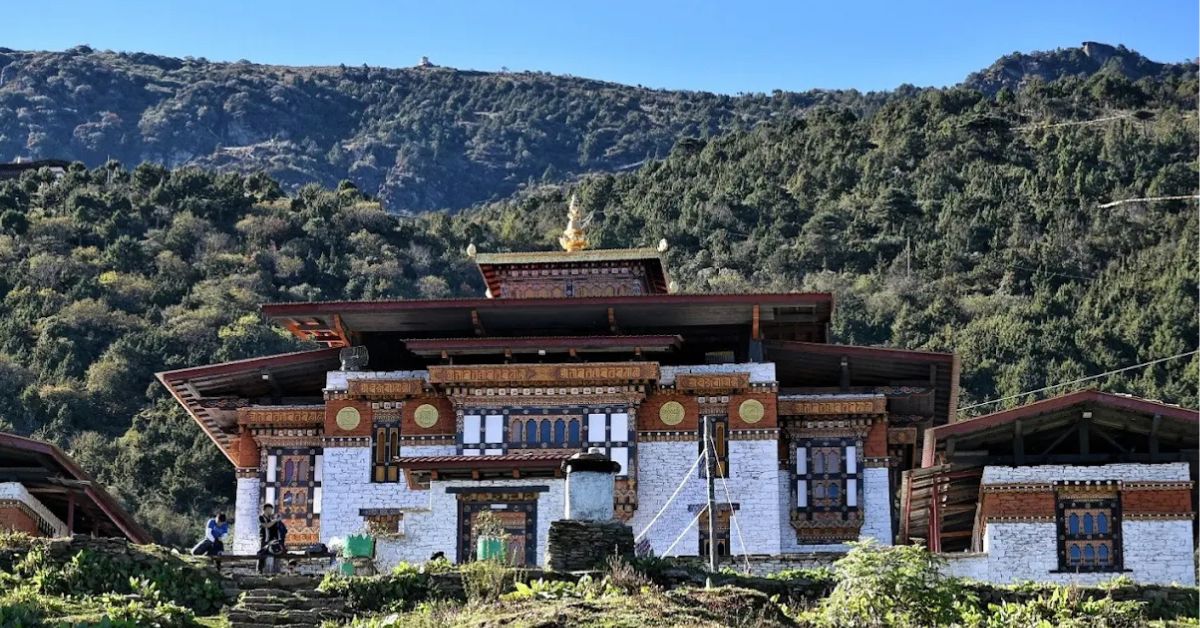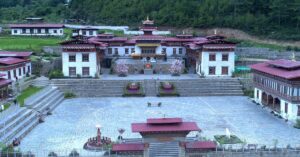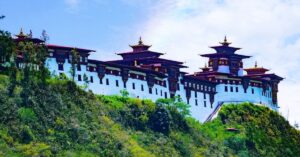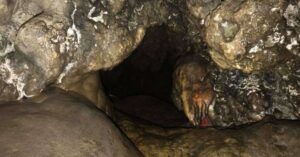Phajoding Monastery, also known as Phajoding Sheydrup Ling Buddhist Institute, is a meditation hermitage founded by Phajo Drugom Zhigpo in the 13th century on the“spacious land of Phajo”. It is situated at an altitude of 4,000 meters, below Thujidra Goenpa and overlooking Thimphu City.
However, the present monastery was built in 1749 by Sherab Wangchuk, 13th Druk Desi. Later, the monastery faced periods of neglect. It was only restored in 2018, and today, it houses 80 young monks.
Phajoding is a destination for thousands of hikers each year. It is also an important stop if you are hiking to Dungtsho Lake. Phajoding-Thujidra is also a part of the popular Druk Path Trek in Bhutan.
How To Reach Phajoding Monastery
How far is the hike to Phajoding? Phajoding Monastery is located 5 km from Thimphu city and takes approximately 3 hours to reach. What is the elevation of Phajoding? Phajoding Goemba is situated at an elevation of between 3,600 and 4,000 meters (13,100 feet).
The starting point for the Phajoding Monastery hike is above the Royal Takin Preserve in Motithang. The trailhead is located near a small tea shop above the preserve and is well-signposted. Another starting point is from Sangaygang, commonly known as the BBS Tower area. It is slightly longer but offers a more gradual ascent. You can also hike to Wangditse Lhakhang from Sangaygang viewpoint.
Phajoding Hike in Thimphu
The Phajoding hike in Thimphu is one of the best day hikes in Thimphu. How long is the hike to Phajoding? The distance is approximately 5 kilometers, and it takes about 3-4 hours to reach the Phajoding monastery.
You can choose the hiking point. One is located above the Motithang Takin Reserve, and the other is situated at the Sangaygang BBS Tower. The former hike is quite steep, while the latter has a more gradual ascent, although it is slightly longer. Both hiking trails run through a lush terrain with numerous resting canopies and benches.
However, if you wish to undertake the Dungtsho hike via Thujidra Top, you can either pitch tents and stay at Phajoding Monastery before continuing.
Sacred Relics to See at Phajoding Monastery
- Library of Buddhist Scriptures;
- Ancient Chortens;
- Meditation Hermitages;
- Temple complex;
- Reliquary stupa and Thongdrel of Shakya Rinchen;
- The Sky Burial hill
History of Phajoding Monastery
According to the history of Phajoding Monastery, Phajo Drugom Zhigpo visited the site, blessed it, and founded a meditation hermitage in the 13th century. The name Phajoding means “Phajo’s spacious land”, derived from Phajo Drugom Zhigpo, and ding, a spacious flat land.
However, the Phajoding monastery was only built in 1749 by the 13th Druk Desi Sherab Wangchuk. The monastery was named “Phajoding Thubten Jago Phungpo Wogmin Nampar Gyalwai Khangzang”, meaning The Temple of the Doctrine of the Buddha, Vulture Peak Mountain, and the Akanishtha Mansion of Complete Victory.
In 1755, Gyalwa Shakya Rinchen, the 9th Je Khenpo, also constructed temples and later retired there. Later, Druk Tenzin, the 19th Druk Desi, and Jampel Draka, the 21st Je Khenpo, sponsored and added more structures.
However, without proper care and with years of neglect, the monastery was listed as one of the Top 5 Endangered Monuments in 2010 by the World Monuments Fund.
Importance of Phajoding Monastery
Phajoding monastery is considered one of the most sacred meditation sites in Bhutan, as Phajo Drugom Zhigpo meditated and founded the temple in the 13th century. Today, it also serves as a refuge and Phajoding Sheydrup Ling Buddhist Institute for over 80 young monks, many of whom are disadvantaged or orphaned.
Phajoding Monastery Conservation Project
The Phajoding Monastery Conservation Project was implemented by the Division for Conservation of Heritage Sites from July 2013 to June 2018, with a grant of Nu 200 million from the Government of India.
During the Conservation Project, the front three rabseys, as well as the timber joists on the ground floor and first floor of Wogmin Lhakhang, were replaced. Khangzang Lhakhang was also restored. The project also included maintenance of footpaths around the temple complex, the chortens, the drainage system, and the improvement of the retaining walls.
The project also built new structures. The layout included a two-story Drasha, a one-story Kitchen and Dining area, a one-story Toilet, and a residence for Ex-Yangpoi Lopen, Boso Karp.
Description of Phajoding Temple Complex
Phajoding Monastery is a large, open complex that includes ten temples, a monastic school, and seven small residences housing around 80 monks. There is also a Sky Burial hill covered with prayer flags.
Of the 10 temples of Phajoding, the largest is the Jampa Lhakhang. It is a three-story stone wall structure built by the 9th Je Khenpo Sakya Rinchen, surrounded by Shabkor walls. We can still see the reliquary stupa that houses his remains.
Higher up from the Jampa Lhakhang on the hillside are two temples called the Khangzang and Wogmin Lhakhangs. The Khangzang Lhakhang is the main temple built by the 9th Je Khenpo Gyalwa Shakya Rinchen. This Lhakhang houses the Thongdrel of Gyalwa Shakya Rinchen, which was consecrated at Changangkha Lhakhang.
Wogmin Lhakhang is a three-storied structure with stonewalls built by the 16th Je-Khenpo Sherub Singye. It was later extended to its present size by the 21st Je Khenpo, Jam Drakpa.
Best Time to Visit Phajoding Monastery
The best time to visit Phajoding Monastery is in the spring (March to May) and autumn (September to November). Spring and autumn are the best seasons for the Phajoding-Thujidra monastery hike.
Conclusion
Phajoding Monastery, founded in the 13th century by Phajo Drugom Zhigpo, is a sacred Buddhist site located about 4,000 meters above Thimphu city. The complex, which includes around ten temples, contains ancient artifacts and relics and hosts approximately 80 young monks in its monastic school. Despite periods of neglect, restoration efforts since 2013 have helped preserve its spiritual and cultural heritage.
Other Sacred Sites to Explore in Thimphu
Buddha Dordenma: It is a massive golden statue of Buddha Shakyamuni overlooking the Thimphu valley. The site also houses thousands of smaller Buddha statues and a meditation hall.
Tashichho Dzong: It is a fortress that houses the king’s throne room, government offices, and the central monastic body. Known as the “Fortress of the Glorious Religion,” it blends religious and administrative functions with stunning Bhutanese architecture.
Pangri Zampa Monastery: It is one of Bhutan’s oldest monasteries, founded in the 16th century by Ngawang Chogyal. The monastery now functions as Bhutan’s Royal College of Astrology, responsible for determining dates for important national events.
Dechenphu Lhakhang: It is a monastery dedicated to Geynyen Jagpa Melen, a powerful protective deity, located at the northern end of the Thimphu Valley in Bhutan. The Temple was constructed in the 12th century by Dampa, the son of Phajo Drugom Zhigpo.
Cheri Monastery: It is the first monastery established in Bhutan by Zhabdrung Ngawang Namgyel in 1620.
Tango Monastery: The Tango Choying Dzong was founded in the 13th century by Phajo Drugom Zhigpo. The monastery is perched on a forested hillside near Cheri Mountain.
Thuji Dra Monastery: It is one of the four cliffs prophesied by Guru Rinpoche to Phajo Drugom Zhigpo. The Thujidra Temple is located at an altitude of nearly 4,000 meters, where Phajo saw in a vision Phagpa Thujechenpo while meditating here.
Enjoyed reading this blog?




